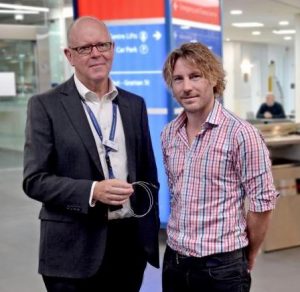
Professor Peter Mitchell and co-researcher Associate Professor Nicholas Opie.
A first in human trial is to start in Victoria of an electronic sensor-enabled brain stent to enable thought-controlled remote functions for patients with paralysis and severe movement disorders.
Principal investigator Professor Peter Mitchell, Director of the Royal Melbourne Hospital Neurointervention Service, says the safety and feasibility trial of the Stentrode device aims to recruit five patients with conditions such as spinal cord injury, stroke, muscular dystrophy, or motor neurone disease, including amyotrophic lateral sclerosis (ALS).
Stentrode comprises a small metallic mesh stent with electrode contacts and a surgical technique that allows implantation in blood vessel of the motor cortex.
The three year trial will investigate whether ‘Thought Controlled Digital Switch” technology is feasible in humans, by assessing the stability of high-fidelity signals from the brain to external communications technologies.
“The real-world effect of this technology is that it will benefit people who are locked into their bodies, who have almost no physical function and can’t speak,” said Professor Mitchell.
“If this trial can successfully provide a brain-to-computer interface, it would allow people with these kinds of injuries and diseases to communicate – this would be amazing,”